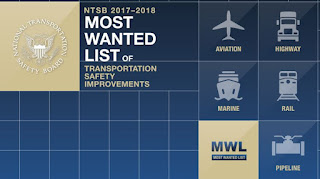On November 14,
2016, The National Transportation Safety Board (NTSB) released its 2017-2018
Most Wanted List of Transportation Safety Improvements. Although transportation
safety has improved substantially since the NTSB was formed almost 50 years
ago, as the NTSB Most Wanted List shows, there are still many transportation
areas that need safety improvement. Among items included on the NTSB Most
Wanted List are eliminating
road distractions, preventing loss of control in flight,
and improving rail
transit safety oversight, all of which contribute to
increased transportation fatalities.
NTSB Most Wanted List Highlights Fatigue, Distractions While Driving
In August 2016,
the National Highway Traffic Safety Administration (NHTSA) announced that from
2014 to 2015, the number of traffic-related
fatalities increased 7.2 percent to more than 35,000. It was
the largest increase in traffic fatalities year-to-year since 1966, and it
ended five decades of declining traffic-related fatalities.
"The data
tell us that people die when they drive drunk, distracted, or drowsy, or if
they are speeding or unbuckled," said NHTSA Administrator Dr. Mark Rosekind. "While there have been
enormous improvements in many of these areas, we need to find new solutions to
end traffic fatalities."
Fatigue-Related Driving Accidents
"According to
the National Highway Traffic Safety Administration, from 2009 to 2013, more than
72,000 police-reported crashes involved drowsy drivers, and
resulted in more than 41,000 injuries and more than 800 deaths," the NTSB
states in its Most Wanted List. "Another study conducted in 2014 by the
AAA Foundation for Traffic Safety estimated that as many as one in five fatal
crashes involve drowsy driving."
The NTSB recommends
that companies establish fatigue risk management programs to reduce the risk of
fatigue-related
accidents. Also included in the more than 200 safety
recommendations to address fatigue, are research into training on and treatment
of sleep disorders. Implementation of technology in vehicles to reduce
fatigue-related accidents is also recommended. This includes electronic logging
devices designed to ensure compliance with regulations involving hours of
service for commercial truck drivers.
In addition to
traffic accidents, fatigue can play a role or be a contributing factor in
aviation and rail accidents. NTSB reports that around 20 percent of the 182
major NTSB investigations undertaking from 2001 to 2012 cited fatigue as
being related to the accident, in some cases as the probable
cause.
Eliminating
Driving Distractions
Operating
vehicles, aircraft or other modes of transportation requires the person in
control to be completely focused on the task at hand. Unfortunately, many
people believe they can multitask while they drive. This includes use of
portable electronic devices while driving, and undertaking any tasks that pull
the focus off of operating the vehicle. According to the NTSB, 10 percent of
all traffic-related deaths were linked to distracted driving.
Public education,
strict laws and tough enforcement are all recommended by the NTSB to curb
distractions.
General
Aviation Safety Improvements
The NTSB Most
Wanted List also addresses general aviation loss of control
as an area that requires fixing. According to the NTSB, roughly 50 percent of
all general aviation (GA) fatalities from 2008 to 2015 were linked to loss of
control. Although the aviation fatality rate in 2015 was the lowest it had been
in years, NTSB notes that there is still room for improvement, especially as it
relates to loss of control.
General
aviation loss of control accidents—in which a domestic
civilian aircraft, not counting a commercial airline, experiences an
"unintended departure from controlled flight"—were the cause of 1,194
fatalities from 2008 to 2014. Among the reasons for a loss of control are pilot
distractions, weather issues or loss of situational awareness.
"GA pilot
proficiency requirements are much less rigorous than those of airline
pilots," the NTSB Most Wanted List notes. "GA pilots are more likely
to have longer intervals between training sessions and between flights. They
typically only need to complete a flight review consisting of, at a minimum, 1
hour of ground training and 1 hour of flight training every 24 months."
The NTSB Most
Wanted List recommends increased training for GA pilots, including ensuring GA
pilots understand stall characteristics and warning signs, learn emergency
response skills and install new technology to assist during critical phases of
flight.
Improving Rail Oversight
According to the
NTSB, safety oversight of rail transit is "unreliable and
inconsistent," which increases the risk of a rail transit accident.
With millions of people relying on rail transit to commute from home to work
daily, it is critical that rail transit safety be closely monitored and
enhanced. NTSB recommends that safety
standards be created and enforced to ensure transit agencies
continually maintain their infrastructure and address issues with safety.
"Rail transit
must be subject to competent oversight bodies that have standards and rules
(and the power to enforce those rules)," NTSB writes. "Although each
rail transit system has unique equipment, operating environments, and
challenges, all need strong safety oversight."
Other
Improvements on NTSB Safety List
Other
transportation improvements included on the NTSB Most Wanted List included
eliminating drug and alcohol impairment in transportation, expanding the use of
recorders to improve safety, strengthening occupant protection, and ensuring
the safe shipment of hazardous materials.
Improvement List Moves to Two-Year Cycle
The NTSB Most
Wanted List has been issued since 1990 to highlight the most important changes
that are needed to improve safety in the transportation industry. When it
released the 2017-2018 list, the NTSB noted that it will shift to a two-year
cycle of releasing the list, rather than releasing it every year. Switching to
a two-year cycle allows members in the industry to implement the changes
recommended before receiving a new list of priority improvements.


Comments
Post a Comment